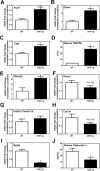The CRH-Transgenic Cushingoid Mouse Is a Model of Glucocorticoid-Induced Osteoporosis
- PMID: 30283880
- PMCID: PMC6124163
- DOI: 10.1002/jbm4.10009
The CRH-Transgenic Cushingoid Mouse Is a Model of Glucocorticoid-Induced Osteoporosis
Abstract
Glucocorticoids (GCs) have unparalleled anti-inflammatory and immunosuppressive properties, which accounts for their widespread prescription and use. Unfortunately, a limitation to GC therapy is a wide range of negative side effects including Cushing's syndrome, a disease characterized by metabolic abnormalities including muscle wasting and osteoporosis. GC-induced osteoporosis occurs in 30% to 50% of patients on GC therapy and thus, represents an important area of study. Herein, we characterize the molecular and physiologic effects of GC-induced osteoporosis using the Cushing's mouse model, the corticotropin releasing hormone (CRH) transgenic mouse (CRH-Tg). The humeri, femurs, and tibias from wild-type (WT) and CRH-Tg male mice, aged 13 to 14 weeks old were subjected to multiple bone tests including, micro-computed tomography (μCT), static and dynamic histomorphometry, strength testing, and gene expression analyses. The CRH-Tg mice had a 38% decrease in cortical bone area, a 35% decrease in cortical thickness, a 16% decrease in trabecular thickness, a sixfold increase in bone adiposity, a 27% reduction in osteoid width, a 75% increase in bone-resorbing osteoclast number/bone surface, a 34% decrease in bone formation rate, and a 40% decrease in bone strength compared to WT mice. At the gene expression level, CRH-Tg bone showed significantly increased osteoclast markers and decreased osteoblast markers, whereas CRH-Tg muscle had increased muscle atrophy gene markers compared to WT mice. Overall, the CRH-Tg mouse model aged to 14 weeks recapitulated many features of osteoporosis in Cushing's syndrome and thus, represents a useful model to study GC-induced osteoporosis and interventions that target the effects of GCs on the skeleton. © 2017 The Authors. JBMR Plus is published by Wiley Periodicals, Inc. on behalf of the American Society for Bone and Mineral Research.
Keywords: BONE HISTOMORPHOMETRY; CORTICOSTEROIDS; CUSHING'S DISEASE; GENETIC ANIMAL MODELS; μCT.
Figures







References
-
- Overman RA, Toliver JC, Yeh JY, Gourlay ML, Deal CL. United States adults meeting 2010 American College of Rheumatology criteria for treatment and prevention of glucocorticoid‐induced osteoporosis. Arthritis Care Res (Hoboken). 2014; 66 (11):1644–52. - PubMed
-
- Boehme SA, Gaur A, Crowe PD, et al. Immunosuppressive phenotype of corticotropin‐releasing factor transgenic mice is reversed by adrenalectomy. Cell Immunol. 1997; 176 (2):103–12. - PubMed
LinkOut - more resources
Full Text Sources
Miscellaneous
